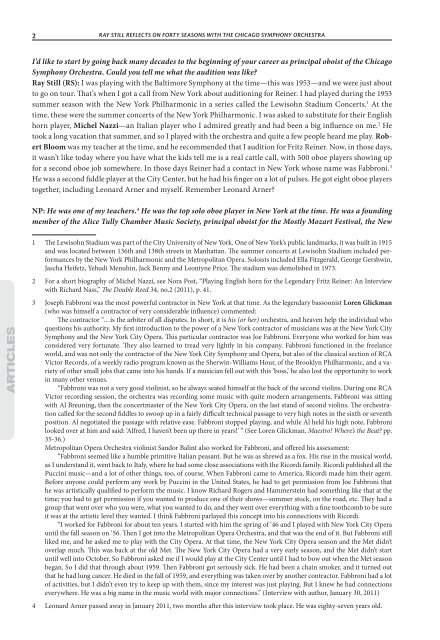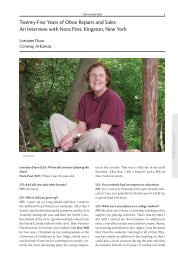Ray Still - Nora Post Inc.
Ray Still - Nora Post Inc.
Ray Still - Nora Post Inc.
Create successful ePaper yourself
Turn your PDF publications into a flip-book with our unique Google optimized e-Paper software.
ARTICLES<br />
2<br />
RAY STILL REFLECTS ON FORTY SEASONS WITH THE CHICAGO SYMPHONY ORCHESTRA<br />
I’d like to start by going back many decades to the beginning of your career as principal oboist of the Chicago<br />
Symphony Orchestra. Could you tell me what the audition was like?<br />
<strong>Ray</strong> <strong>Still</strong> (RS): I was playing with the Baltimore Symphony at the time—this was 1953—and we were just about<br />
to go on tour. That’s when I got a call from New York about auditioning for Reiner. I had played during the 1953<br />
summer season with the New York Philharmonic in a series called the Lewisohn Stadium Concerts. 1 At the<br />
time, these were the summer concerts of the New York Philharmonic. I was asked to substitute for their English<br />
horn player, Michel Nazzi—an Italian player who I admired greatly and had been a big influence on me. 2 He<br />
took a long vacation that summer, and so I played with the orchestra and quite a few people heard me play. Robert<br />
Bloom was my teacher at the time, and he recommended that I audition for Fritz Reiner. Now, in those days,<br />
it wasn’t like today where you have what the kids tell me is a real cattle call, with 500 oboe players showing up<br />
for a second oboe job somewhere. In those days Reiner had a contact in New York whose name was Fabbroni. 3<br />
He was a second fiddle player at the City Center, but he had his finger on a lot of pulses. He got eight oboe players<br />
together, including Leonard Arner and myself. Remember Leonard Arner?<br />
NP: He was one of my teachers. 4 He was the top solo oboe player in New York at the time. He was a founding<br />
member of the Alice Tully Chamber Music Society, principal oboist for the Mostly Mozart Festival, the New<br />
1 The Lewisohn Stadium was part of the City University of New York. One of New York’s public landmarks, it was built in 1915<br />
and was located between 136th and 138th streets in Manhattan. The summer concerts at Lewisohn Stadium included performances<br />
by the New York Philharmonic and the Metropolitan Opera. Soloists included Ella Fitzgerald, George Gershwin,<br />
Jascha Heifetz, Yehudi Menuhin, Jack Benny and Leontyne Price. The stadium was demolished in 1973.<br />
2 For a short biography of Michel Nazzi, see <strong>Nora</strong> <strong>Post</strong>, “Playing English horn for the Legendary Fritz Reiner: An Interview<br />
with Richard Nass,” The Double Reed 34, no.2 (2011), p. 41.<br />
3 Joseph Fabbroni was the most powerful contractor in New York at that time. As the legendary bassoonist Loren Glickman<br />
(who was himself a contractor of very considerable influence) commented:<br />
The contractor “…is the arbiter of all disputes. In short, it is his (or her) orchestra, and heaven help the individual who<br />
questions his authority. My first introduction to the power of a New York contractor of musicians was at the New York City<br />
Symphony and the New York City Opera. This particular contractor was Joe Fabbroni. Everyone who worked for him was<br />
considered very fortunate. They also learned to tread very lightly in his company. Fabbroni functioned in the freelance<br />
world, and was not only the contractor of the New York City Symphony and Opera, but also of the classical section of RCA<br />
Victor Records, of a weekly radio program known as the Sherwin-Williams Hour, of the Brooklyn Philharmonic, and a variety<br />
of other small jobs that came into his hands. If a musician fell out with this ‘boss,’ he also lost the opportunity to work<br />
in many other venues.<br />
“Fabbroni was not a very good violinist, so he always seated himself at the back of the second violins. During one RCA<br />
Victor recording session, the orchestra was recording some music with quite modern arrangements. Fabbroni was sitting<br />
with Al Breuning, then the concertmaster of the New York City Opera, on the last stand of second violins. The orchestration<br />
called for the second fiddles to swoop up in a fairly difficult technical passage to very high notes in the sixth or seventh<br />
position. Al negotiated the passage with relative ease. Fabbroni stopped playing, and while Al held his high note, Fabbroni<br />
looked over at him and said: ‘Alfred, I haven’t been up there in years!’ ” (See Loren Glickman, Maestro! Where’s the Beat? pp.<br />
35-36.)<br />
Metropolitan Opera Orchestra violinist Sandor Balint also worked for Fabbroni, and offered his assessment:<br />
“Fabbroni seemed like a humble primitive Italian peasant. But he was as shrewd as a fox. His rise in the musical world,<br />
as I understand it, went back to Italy, where he had some close associations with the Ricordi family. Ricordi published all the<br />
Puccini music—and a lot of other things, too, of course. When Fabbroni came to America, Ricordi made him their agent.<br />
Before anyone could perform any work by Puccini in the United States, he had to get permission from Joe Fabbroni that<br />
he was artistically qualified to perform the music. I know Richard Rogers and Hammerstein had something like that at the<br />
time; you had to get permission if you wanted to produce one of their shows—summer stock, on the road, etc. They had a<br />
group that went over who you were, what you wanted to do, and they went over everything with a fine toothcomb to be sure<br />
it was at the artistic level they wanted. I think Fabbroni parlayed this concept into his connections with Ricordi.<br />
“I worked for Fabbroni for about ten years. I started with him the spring of ‘46 and I played with New York City Opera<br />
until the fall season on ‘56. Then I got into the Metropolitan Opera Orchestra, and that was the end of it. But Fabbroni still<br />
liked me, and he asked me to play with the City Opera. At that time, the New York City Opera season and the Met didn’t<br />
overlap much. This was back at the old Met. The New York City Opera had a very early season, and the Met didn’t start<br />
until well into October. So Fabbroni asked me if I would play at the City Center until I had to bow out when the Met season<br />
began. So I did that through about 1959. Then Fabbroni got seriously sick. He had been a chain smoker, and it turned out<br />
that he had lung cancer. He died in the fall of 1959, and everything was taken over by another contractor. Fabbroni had a lot<br />
of activities, but I didn’t even try to keep up with them, since my interest was just playing. But I knew he had connections<br />
everywhere. He was a big name in the music world with major connections.” (Interview with author, January 30, 2011)<br />
4 Leonard Arner passed away in January 2011, two months after this interview took place. He was eighty-seven years old.



